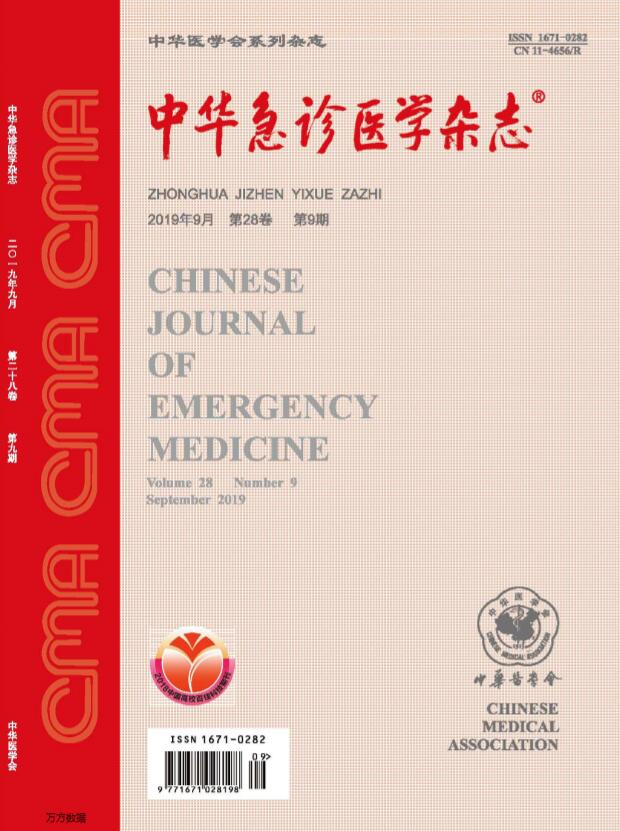Effect of mean arterial pressure on acute kidney injury in patients with septic shock
Q4 Nursing
引用次数: 0
Abstract
Objective To study the effect of mean arterial pressure (MAP) level on acute kidney injury (AKI) in patients with septic shock, and to determine the best resuscitation target MAP to prevent the occurrence or progression of sepsis- associated AKI. Methods The study subjects included 168 adult patients with septic shock (age≥65 years) who were admitted to the Department of Intensive Care Unit (ICU) of the First Hospital of Jilin University from January 2016 to January 2019. The clinical data of all enrolled patients were retrospectively analyzed. The baseline data were compared between the AKI group (n=111) and non-AKI group (n=57). Multivariate logistic regression analysis was used to determine the risk factors of AKI in patients with septic shock. Results ① The first, second, third, and forth quartile of ΔMAP (pre-resuscitation MAP minus post-resuscitation MAP) were -24.3-3.9 mmHg, 4.0-12.3 mmHg, 12.4-19.8 mmHg, and 19.9-43.5 mmHg, respectively. The second to fourth quartile interval wasΔMAP ≥4 mmHg.② There were no significant differences in age, body mass index, sex, pre-resuscitation MAP, MAP at first hour, SOFA score, positive culture ratio, negative culture ratio, hypertension, peripheral vascular disease, cerebrovascular accident, chronic obstructive pulmonary disease, gastrointestinal ulcer, liver cirrhosis, and tumor between the two groups (P>0.05). There were significant differences in post-resuscitation MAP (P=0.01), APACHEⅡ score (P=0.02), diabetes mellitus (P=0.01), fluid balance (P=0.01), and ΔMAP from the second to fourth quartile (P=0.03) between the two groups.③ ΔMAP ≥4 mmHg (OR=0.26, 95%CI: 0.12-0.57, P=0.01), diabetes (OR=6.03, 95%CI: 1.35-44.16, P=0.04), and high APACHE Ⅱ score (OR=0.96, 95%CI: 0.84-0.97, P=0.02) were closely related to the increased incidence of AKI in patients with septic shock. Post-resuscitation MAP and fluid balance had no significant effect on the incidence of AKI in patients with septic shock. Conclusions ΔMAP ≥4 mmHg, APACHE Ⅱ score and diabetes were independent risk factors for the incidence of AKI in patients with septic shock. The incidence of AKI in septic shock patients with post-resuscitation MAP 4 mmHg or more lower than pre-resuscitation MAP is significantly increased. Key words: Septic shock; Mean arterial pressure; Acute kidney injury; Risk factors平均动脉压对感染性休克患者急性肾损伤的影响
目的研究平均动脉压(MAP)水平对感染性休克患者急性肾损伤(AKI)的影响,确定预防败血症相关AKI发生或发展的最佳复苏靶点MAP。方法研究对象包括2016年1月至2019年1月入住吉林大学第一医院重症监护室(ICU)的168名感染性休克(年龄≥65岁)成年患者。对所有入选患者的临床资料进行回顾性分析。比较AKI组(n=111)和非AKI组的基线数据(n=57)。采用多因素logistic回归分析确定感染性休克患者AKI的危险因素。结果①ΔMAP的第一、第二、第三和第四个四分位数(复苏前MAP减去复苏后MAP)分别为-24.3mmHg、4.0-12.3 mmHg、12.4-1.8 mmHg和19.9-43.5 mmHg。ΔMAP≥4mmHg。②年龄、体重指数、性别、复苏前MAP、第一小时MAP、SOFA评分、阳性培养率、阴性培养率、高血压、外周血管疾病、脑血管意外、慢性阻塞性肺病、胃肠道溃疡、肝硬化、,两组复苏后MAP(P=0.01)、APACHEⅡ评分(P=0.02)、糖尿病(P=0.01ΔMAP≥4mmHg(OR=0.26,95%CI:0.12-0.57,P=0.01)、糖尿病(OR=6.03,95%CI:1.35-44.16,P=0.04)和APACHEⅡ评分高(OR=0.96,95%CI:0.84-0.97,P=0.02)与感染性休克患者AKI发生率增加密切相关。复苏后MAP和液体平衡对感染性休克患者AKI的发生率没有显著影响。结论ΔMAP≥4mmHg、APACHEⅡ评分和糖尿病是感染性休克患者AKI发生的独立危险因素。感染性休克患者复苏后MAP低于复苏前MAP 4mmHg或以上时,AKI的发生率显著增加。关键词:败血症休克;平均动脉压;急性肾损伤;风险因素
本文章由计算机程序翻译,如有差异,请以英文原文为准。
求助全文
约1分钟内获得全文
求助全文
来源期刊

中华急诊医学杂志
Nursing-Emergency Nursing
CiteScore
0.10
自引率
0.00%
发文量
8629
期刊介绍:
Chinese Journal of Emergency Medicine is the only national journal which represents the development of emergency medicine in China. The journal is supervised by China Association of Science and Technology, sponsored by Chinese Medical Association, and co-sponsored by Zhejiang University. The journal publishes original research articles dealing with all aspects of clinical practice and research in emergency medicine. The columns include Pre-Hospital Rescue, Emergency Care, Trauma, Resuscitation, Poisoning, Disaster Medicine, Continuing Education, etc. It has a wide coverage in China, and builds up communication with Hong Kong, Macao, Taiwan and international emergency medicine circles.
 求助内容:
求助内容: 应助结果提醒方式:
应助结果提醒方式:


